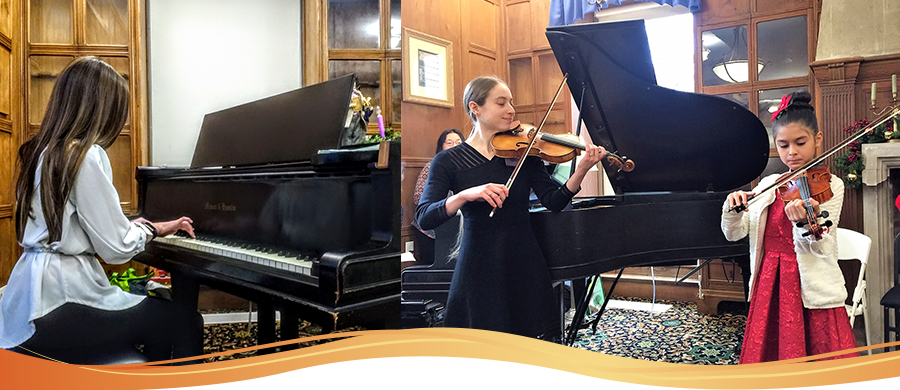
Online
Music for the Community
If you're interested in a particular category, you can sort performances by student age, instrument, singalong music, composer and so on - click on the orange tags under the text. We hope you and your family will enjoy watching our students share their music!
To have each week's videos and accompanying info sent to your inbox*, please subscribe via the orange button.
*Videos are delivered twice weekly; you can unsubscribe at any time, and we will never share or sell your info.
Subscribe to this Page
Finding the Time to Practice
“I didn’t have time to practice this week.”
When I started what was then Wayland Violin Studio back in 1997, I didn’t yet have children, and wasn't aware of how packed with activities kids' lives are these days. So the first time I heard that statement, I asked my student, “Well, what time do you get home from school?” and then “How much homework do you have, and what time do you go to bed?”- naively expecting to lead the student gently to the realization that yes, endless free hours were available to fit in that little bit of practice!
Well……you can guess how the rest of that conversation went. By the time I had heard about twice-weekly religious school, soccer practice at least twice a week with traveling games every weekend, and after-school math tutoring, I was wondering how this child managed to practice at all, in any week!
But if you’re wondering the same thing – be reassured that there is hope, and a way to make everything (not just practice) seem much more manageable and less overwhelming. It’s the useful skill of time-chunking.
If you can chunk your time and set up a workable plan, half the job is done. Once practice becomes a predictable and routine item like brushing your teeth and doing your homework, it tends to get done without complaint - or at least with less complaint! Yes, it takes a bit of planning - but that planning is an investment that can actually help your whole evening go more smoothly, not just the practice. Here’s how to do it:
First, make a table like this one with your child. I’ve done this one with 30 minute increments, but you could do it with 15 minute increments if that suits your situation better.
|
|
Mon |
Tues |
Weds |
Thurs |
Fri |
|
Sat |
Sun |
|
3:30 |
|
|
|
|
|
|
|
|
|
4:00 |
|
|
|
|
|
|
|
|
|
4:30 |
|
|
|
|
|
|
|
|
|
5:00 |
|
|
|
|
|
|
|
|
|
5:30 |
|
|
|
|
|
|
|
|
|
6:00 |
|
|
|
|
|
|
|
|
|
6:30 |
|
|
|
|
|
|
|
|
|
7:00 |
|
|
|
|
|
|
|
|
|
7:30 |
|
|
|
|
|
|
|
|
|
8:00 |
|
|
|
|
|
|
|
|
|
8:30 |
|
|
|
|
|
|
|
|
To fill out the table, we’ll use an imaginary student named Joey. Joey is in 4th grade. His violin lesson is on Friday at 5.00. His teacher expects him to do about 30 minutes of practice, 5 – 6 times a week. Let’s see if that is practical.
On school days he gets home at 3:30pm, and his bedtime is 9pm. He has up to an hour a night of homework. He also has an after-school math tutor on Mondays and Fridays.
On Monday and Wednesday he has soccer practice from 5:00-6:30, and on Thursday he has religious school from 3:30-5:00 (he goes there straight from school). He has dinner (which takes 30 minutes) at 7 on M and W, and at 6 on the other days.
Probably your head is already spinning! But once we put all this in the chart, it’s much easier to wrap our minds around it:
|
|
Mon |
Tues |
Weds |
Thurs |
Fri |
|
Sat |
Sun |
|
3:30 |
|
|
|
Religious Ed |
|
|
|
|
|
4:00 |
Tutor |
|
|
Religious Ed |
Tutor |
|
|
|
|
4:30 |
|
|
|
Religious Ed |
|
|
|
|
|
5:00 |
Soccer |
|
Soccer |
|
Violin lesson |
|
|
|
|
5:30 |
Soccer |
|
Soccer |
|
|
|
|
|
|
6:00 |
Soccer |
Dinner |
Soccer |
Dinner |
Dinner |
|
|
|
|
6:30 |
|
|
|
|
|
|
|
|
|
7:00 |
Dinner |
|
Dinner |
|
|
|
|
|
|
7:30 |
|
|
|
|
|
|
|
|
|
8:00 |
|
|
|
|
|
|
|
|
|
8:30 |
|
|
|
|
|
|
|
|
Now, how can we fit in his homework and his violin practice? Looking at the spaces that are left on the chart, here’s a plan that could work for Joey.
Monday is his heaviest homework day, so he could take that as his day off from practice. On Tuesday, he could relax for an hour on arriving from school, do his homework before dinner, and then practice after dinner from 7:00-7:30. On Wednesday, he could do homework before soccer, and again practice after dinner - or the reverse if he prefers. On Thursday, he could practice between religious school and dinner, doing homework after dinner. And on Saturday and Sunday, it should be easier to fit in 30 minutes of violin.
Now Joey’s schedule looks like this:
|
|
Mon |
Tues |
Weds |
Thurs |
Fri |
|
Sat |
Sun |
|
3:30 |
|
|
|
Religious Ed |
|
|
Practice |
Practice |
|
4:00 |
Tutor |
|
Homework |
Religious Ed |
Tutor |
|
(flexible |
time) |
|
4:30 |
|
|
Homework |
Religious Ed |
|
|
|
|
|
5:00 |
Soccer |
Homework |
Soccer |
|
Violin lesson |
|
Home….. (flexible |
…work time) |
|
5:30 |
Soccer |
Homework |
Soccer |
Practice |
|
|
|
|
|
6:00 |
Soccer |
Dinner |
Soccer |
Dinner |
Dinner |
|
|
|
|
6:30 |
|
Practice |
|
|
|
|
|
|
|
7:00 |
Dinner |
|
Dinner |
Homework |
|
|
|
|
|
7:30 |
|
|
Practice |
Homework |
|
|
|
|
|
8:00 |
|
|
|
|
|
|
|
|
|
8:30 |
|
|
|
|
|
|
|
|
There we go: 5 practice sessions of 30 minutes accounted for, and he will be making excellent progress! Also – and this is very important – he still has some downtime every day when he can play or just vegetate.
It’s important to involve your child in this planning process, and to allow some choices. The more input s/he has, the more investment s/he will feel. Perhaps you feel that homework should always be done first, but if your child argues for doing practice first on some days, consider giving it a try and seeing how it works out. Learning this skill of time-chunking, and following through on it, can be a very empowering experience for your child.
What's more, getting good at time-chunking will not only help your child to feel more in control of his or her time right now. It’s also a valuable life skill that kids can use to manage the increasing responsibilities that come their way as they move on through school and college, and into adult life.
Enjoyed this post? Please consider emailing it to a friend or sharing it on Facebook!
I signed my child up for private lessons . . . now what?
Your child’s orchestra or band teacher recommended private lessons. You did your research, came for a tryout lesson, and found a good match for your child with an enthusiastic and experienced teacher. What next?
First of all – congratulations! You just helped not only your own child, but your child’s orchestra or band teacher, and the other beginning musicians in the class. Our local school music teachers, whose outstanding programs do a wonderful job of introducing students to their instruments, encourage private lessons right from the start. They know that hands on, one-to-one help from a good private teacher will make your child a more confident and better-prepared student, and thereby help raise the standard for everyone in the class.
Here’s how you can help your budding instrumentalist get the most value from his or her private lessons right from the get-go:
- Set up a good practice space. Your young musician needs good lighting, room to move as the instrument requires, a stable music stand, and ideally a mirror to check hand and body positions (a picture is worth a thousand words – especially when it’s a picture of yourself). And of course, the space should be free of any electronic distractions – including a loud TV or stereo in the next room.
- Help your child figure out an evening routine that factors in time for practice. You learn to play an instrument by doing it, and doing it often. Planning ahead makes it much more likely that regular practice will happen. Shorter daily or near-daily sessions are the way to go; last-minute cramming doesn’t work, especially when you’re trying to build muscle memory.
- Make sure your child checks the private lesson notebook and the school music website (or check yourself along with a younger child) before practicing, so that time is used effectively and required material covered before the next lesson or class.
- Ask your child to share some of his new pieces with you – and applaud his efforts, even if they’re a little squeaky. Getting a sound out of a new-to-you instrument is not easy, and beginning musicians need lots of encouragement!
- Ask your child to teach you one or two of the techniques covered in class, or mentioned in the notebook – especially if you yourself can barely figure out how to hold the instrument! Teaching the material to someone else is a terrific way for your child to reinforce what she’s learned at her lesson, but that’s not all. When she sees you struggling with something that she’s already getting better at herself, she’ll feel empowered and successful, and encouraged to do more.
Some of these points will be covered in more detail in future blog posts. Meanwhile, call and ask us if you have any questions!
Enjoyed this post? Please consider emailing it to a friend or sharing it on Facebook!


